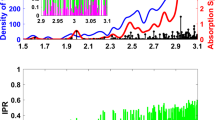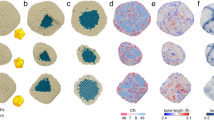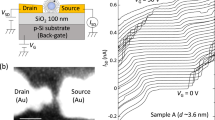Abstract
Nanosized inorganic particles are of great interest because their electronic properties can be easily tailored, providing a tremendous potential for applications in optoelectronic devices, light-emitting diodes1, solar cells2,3,4 and hydrogen storage5. Confinement of electrons and holes to dimensions comparable to their wavelength leads to quantum-well states with modified wavefunctions and density of states6. Surface phenomena are crucial in determining nanoparticle properties in view of their large surface-to-volume ratio. Despite a wealth of information, many fundamental questions about the nature of the surface and its relationship with the electronic structure remain unsolved. Ab initio calculations on CdSe nanocrystals7 suggest that passivating the ligands does not produce the ideal wurtzite structure and that Se atoms relax outwards irrespective of passivation. Here we show that implanted positrons are trapped at the surface of CdSe nanocrystals. They annihilate mostly with the Se electrons, monitor changes in composition and structure of the surface while hardly sensing the ligand molecules, and we thus unambiguously confirm the predicted strong surface relaxation.
This is a preview of subscription content, access via your institution
Access options
Subscribe to this journal
Receive 12 print issues and online access
$259.00 per year
only $21.58 per issue
Buy this article
- Purchase on Springer Link
- Instant access to full article PDF
Prices may be subject to local taxes which are calculated during checkout





Similar content being viewed by others
References
Schlamp, M. C., Peng, X. & Alivisatos, A. P. Improved efficiencies in light emitting diodes made with CdSe(CdS) core/shell type nanocrystals and a semiconducting polymer. J. Appl. Phys. 82, 5837–5842 (1997).
Huynh, W. U., Dittmer, J. J. & Alivisatos, A. P. Hybrid nanorod-polymer solar cells. Science 295, 2425–2427 (2002).
O’Regan, B. & Grätzel, M. A low-cost, high-efficiency solar cell based on dye-sensitized colloidal TiO2 films. Nature 353, 737–739 (1991).
Bach, U. et al. Solid-state dye-sensitized mesoporous TiO2 solar cells with high photon-to-electron conversion efficiencies. Nature 395, 583–585 (1998).
Nutzenädel, C., Züttel, A., Chartouni, D., Schmid, G. & Schlapbach, L. Critical size and surface effect of the hydrogen interaction of palladium clusters. Eur. Phys. J. D 8, 245–250 (2000).
Bányai, L. & Koch, S. W. Semiconductor Quantum Dots (World Scientific, Singapore, 1993).
Puzder, A., Williamson, A. J., Gygi, F. & Galli, G. Self-healing of CdSe nanocrystals: First-principles calculations. Phys. Rev. Lett. 92, 217401 (2004).
Murray, C. B., Kagan, C. R. & Bawendi, M. G. Synthesis and characterization of monodisperse nanocrystals and close-packed nanocrystal assemblies. Annu. Rev. Mater. Res. 30, 545–610 (2000).
Alivisatos, A. P. Semiconductor clusters, nanocrystals, and quantum dots. Science 271, 933–937 (1996).
Manna, L., Scher, E. C., Li, L.-S. & Alivisatos, A. P. Epitaxial growth and photochemical annealing of graded CdS/ZnS shells on colloidal CdSe nanorods. J. Am. Chem. Soc. 124, 7136–7145 (2002).
Van Huis, M. A. et al. Positron confinement in embedded lithium nanoclusters. Phys. Rev. B 65, 085416 (2002).
Weber, M. H., Lynn, K. G., Barbiellini, B., Sterne, P. A. & Denison, A. B. Direct observation of energy-gap scaling law in CdSe quantum dots with positrons. Phys. Rev. B 66, 041305(R) (2002).
West, R. N. in Positron Spectroscopy of Solids (eds Dupasquier, A. & Mills, A. P. Jr) (IOS Press, Amsterdam, 1995).
Van Veen, A., Schut, H. & Mijnarends, P. E. in Positron Beams and their Applications (ed. Coleman, P. G.) (World Scientific, Singapore, 2000).
Liszkay, L. et al. Positron annihilation in ZnSe layers grown on GaAs: Zinc vacancies and drift in the electric field at the ZnSe/GaAs interface. Appl. Phys. Lett. 70, 2723–2725 (1997).
Saarinen, K. et al. Identification of the native vacancy defects in both sublattices of ZnSxSe1−x by positron annihilation. Phys. Rev. Lett. 77, 3407–3410 (1996).
Gebauer, J., Krause-Rehberg, R., Prokesch, M. & Irmscher, K. Identification and quantitative evaluation of compensating Zn-vacancy-donor complexes in ZnSe by positron annihilation. Phys. Rev. B 66, 115206 (2002).
Falub, C. V. et al. Electronic structure and orientation relationship of Li nanoclusters embedded in MgO studied by depth-selective positron annihilation two-dimensional angular correlation. Phys. Rev. B 66, 075426 (2002).
Van Veen, A. et al. Intense positron sources and their applications. Mater. Sci. Forum 363–365, 415–419 (2001).
Van Veen, A., Schut, H., Labohm, F. & de Roode, J. Positron extraction and transport in a nuclear-reactor-based positron beam. Nucl. Instrum. Methods A 427, 266–270 (1999).
Mijnarends, P. E. & Bansil, A. in Positron Spectroscopy of Solids (eds Dupasquier, A. & Mills, A. P. Jr) (IOS Press, Amsterdam, 1995).
Bansil, A., Kaprzyk, S., Mijnarends, P. E. & Toboła, J. Electronic structure and magnetism of Fe3−xVxX (X= Si, Ga, and Al) alloys by the KKR-CPA method. Phys. Rev. B 60, 13396–13412 (1999).
Betts, D. D., Bhatia, A. B. & Horton, G. K. Debye characteristic temperatures of certain noncubic crystals. Phys. Rev. 104, 43–47 (1956).
Betts, D. D., Bhatia, A. B. & Wyman, M. Houston’s method and its application to the calculation of characteristic temperatures of cubic crystals. Phys. Rev. 104, 37–42 (1956).
Saniz, R., Barbiellini, B. & Denison, A. Compton scattering, positron annihilation, and the electronic properties of quantum dots. Phys. Rev. B 65, 245310 (2002).
Plazaola, F., Seitsonen, A. P. & Puska, M. J. Positron annihilation in II–VI compound semiconductors: theory. J. Phys. Condens. Matter 6, 8809–8827 (1994).
Krause-Rehberg, R. & Leipner, H. S. Positron Annihilation in Semiconductors 318–319 (Springer, Berlin, 1999).
Bowen Katari, J. E., Colvin, V. L. & Alivisatos, A. P. X-ray photoelectron spectroscopy of CdSe nanocrystals with applications to studies of the nanocrystal surface. J. Phys. Chem. 98, 4109–4117 (1994).
Taylor, J., Kippeny, T. & Rosenthal, S. J. Surface stoichiometry of CdSe nanocrystals determined by Rutherford backscattering spectroscopy. J. Clust. Sci. 12, 571–582 (2001).
Acknowledgements
This work is supported by the USDOE contract DE-AC03-76SF00098, and benefited from the allocation of supercomputer time at NERSC, Northeastern University’s Advanced Scientific Computation Center (ASCC) and the NCF (Foundation National Computer Facilities) with support from NWO. We thank N. Zaitseva for the generous supply of CdSe quantum-dot samples and A. Houtepen and D. A. M. Vanmaekelbergh for the pyridine-capped CdSe quantum-dot sample.
Author information
Authors and Affiliations
Corresponding author
Ethics declarations
Competing interests
The authors declare no competing financial interests.
Rights and permissions
About this article
Cite this article
Eijt, S., van Veen, A., Schut, H. et al. Study of colloidal quantum-dot surfaces using an innovative thin-film positron 2D-ACAR method. Nature Mater 5, 23–26 (2006). https://doi.org/10.1038/nmat1550
Received:
Accepted:
Published:
Issue Date:
DOI: https://doi.org/10.1038/nmat1550
This article is cited by
-
Nanophotonics for pair production
Nature Communications (2023)
-
Synthesis and defect characterization of hybrid ceria nanostructures as a possible novel therapeutic material towards COVID-19 mitigation
Scientific Reports (2022)
-
Modeling Highly Resolved Spectroscopies of Complex Materials
Journal of Superconductivity and Novel Magnetism (2012)



